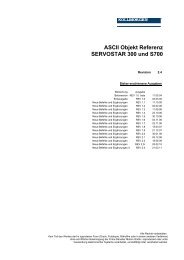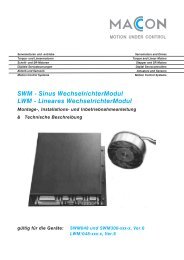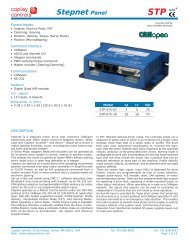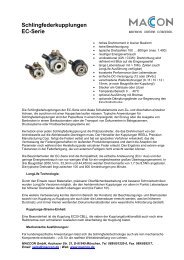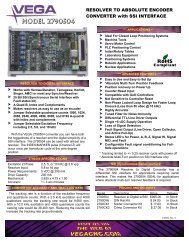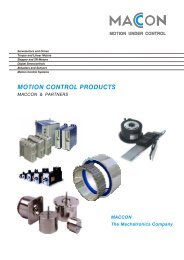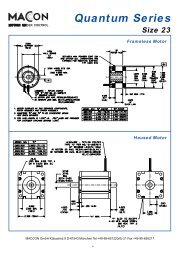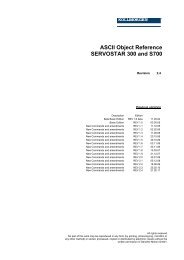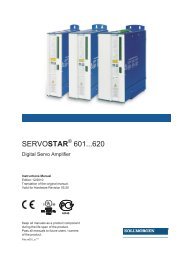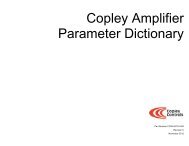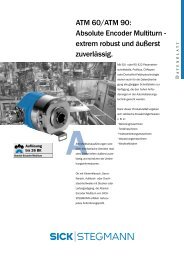- Page 1: CANopen Programmer’s Manual Part
- Page 5 and 6: CANopen Programmer’s Manual Table
- Page 7 and 8: About this Manual CANopen Programme
- Page 9 and 10: About this Manual CANopen Programme
- Page 11: CHAPTER 1: INTRODUCTION This chapte
- Page 15 and 16: CANopen Programmer’s Manual 1: In
- Page 17 and 18: CANopen Programmer’s Manual 1: In
- Page 19 and 20: CANopen Programmer’s Manual 1: In
- Page 21 and 22: CANopen Programmer’s Manual 1: In
- Page 23 and 24: CANopen Programmer’s Manual 1: In
- Page 25 and 26: CANopen Programmer’s Manual 1: In
- Page 27 and 28: CANopen Programmer’s Manual 1: In
- Page 29 and 30: CANopen Programmer’s Manual 1: In
- Page 31 and 32: CANopen Programmer’s Manual 1: In
- Page 33 and 34: CANopen Programmer’s Manual 1: In
- Page 35 and 36: CANopen Programmer’s Manual 1: In
- Page 37 and 38: CANopen Programmer’s Manual 1: In
- Page 39 and 40: CHAPTER 2: NETWORK MANAGEMENT This
- Page 41 and 42: CANopen Programmer’s Manual 2: Ne
- Page 43 and 44: CANopen Programmer’s Manual 2: Ne
- Page 45 and 46: CANopen Programmer’s Manual 2: Ne
- Page 47 and 48: CANopen Programmer’s Manual 2: Ne
- Page 49 and 50: CANopen Programmer’s Manual 2: Ne
- Page 51 and 52: CHAPTER 3: DEVICE CONTROL, CONFIGUR
- Page 53 and 54: CANopen Programmer’s Manual 3: De
- Page 55 and 56: CANopen Programmer’s Manual 3: De
- Page 57 and 58: CANopen Programmer’s Manual 3: De
- Page 59 and 60: CANopen Programmer’s Manual 3: De
- Page 61 and 62: CANopen Programmer’s Manual 3: De
- Page 63 and 64:
CANopen Programmer’s Manual 3: De
- Page 65 and 66:
CANopen Programmer’s Manual 3: De
- Page 67 and 68:
CANopen Programmer’s Manual 3: De
- Page 69 and 70:
CANopen Programmer’s Manual 3: De
- Page 71 and 72:
CANopen Programmer’s Manual 3: De
- Page 73 and 74:
CANopen Programmer’s Manual 3: De
- Page 75 and 76:
CANopen Programmer’s Manual 3: De
- Page 77 and 78:
CANopen Programmer’s Manual 3: De
- Page 79 and 80:
CANopen Programmer’s Manual 3: De
- Page 81 and 82:
CANopen Programmer’s Manual 3: De
- Page 83 and 84:
CANopen Programmer’s Manual 3: De
- Page 85 and 86:
CANopen Programmer’s Manual 3: De
- Page 87 and 88:
CANopen Programmer’s Manual 3: De
- Page 89 and 90:
CANopen Programmer’s Manual 3: De
- Page 91 and 92:
CANopen Programmer’s Manual 3: De
- Page 93 and 94:
CANopen Programmer’s Manual 3: De
- Page 95 and 96:
CANopen Programmer’s Manual 3: De
- Page 97 and 98:
CANopen Programmer’s Manual 3: De
- Page 99 and 100:
CANopen Programmer’s Manual 3: De
- Page 101 and 102:
CANopen Programmer’s Manual 3: De
- Page 103 and 104:
CANopen Programmer’s Manual 3: De
- Page 105 and 106:
CANopen Programmer’s Manual 3: De
- Page 107 and 108:
CANopen Programmer’s Manual 3: De
- Page 109 and 110:
CANopen Programmer’s Manual 3: De
- Page 111 and 112:
CANopen Programmer’s Manual 3: De
- Page 113 and 114:
CANopen Programmer’s Manual 3: De
- Page 115 and 116:
CANopen Programmer’s Manual 3: De
- Page 117 and 118:
CANopen Programmer’s Manual 3: De
- Page 119 and 120:
CANopen Programmer’s Manual 3: De
- Page 121 and 122:
CANopen Programmer’s Manual 3: De
- Page 123 and 124:
CANopen Programmer’s Manual 3: De
- Page 125 and 126:
CANopen Programmer’s Manual 3: De
- Page 127 and 128:
CHAPTER 4: CONTROL LOOP CONFIGURATI
- Page 129 and 130:
CANopen Programmer’s Manual 4: Co
- Page 131 and 132:
CANopen Programmer’s Manual 4: Co
- Page 133 and 134:
CANopen Programmer’s Manual 4: Co
- Page 135 and 136:
CANopen Programmer’s Manual 4: Co
- Page 137 and 138:
CANopen Programmer’s Manual 4: Co
- Page 139 and 140:
CANopen Programmer’s Manual 4: Co
- Page 141 and 142:
CANopen Programmer’s Manual 4: Co
- Page 143 and 144:
CANopen Programmer’s Manual 4: Co
- Page 145 and 146:
CANopen Programmer’s Manual 4: Co
- Page 147 and 148:
CANopen Programmer’s Manual 4: Co
- Page 149 and 150:
CANopen Programmer’s Manual 4: Co
- Page 151 and 152:
CANopen Programmer’s Manual 4: Co
- Page 153 and 154:
CANopen Programmer’s Manual 4: Co
- Page 155 and 156:
CANopen Programmer’s Manual 4: Co
- Page 157 and 158:
CANopen Programmer’s Manual 4: Co
- Page 159 and 160:
CANopen Programmer’s Manual 5: St
- Page 161 and 162:
CANopen Programmer’s Manual 5: St
- Page 163 and 164:
CANopen Programmer’s Manual 5: St
- Page 165 and 166:
CANopen Programmer’s Manual 6: Ho
- Page 167 and 168:
CANopen Programmer’s Manual 6: Ho
- Page 169 and 170:
CANopen Programmer’s Manual 6: Ho
- Page 171 and 172:
CANopen Programmer’s Manual 6: Ho
- Page 173 and 174:
CANopen Programmer’s Manual 6: Ho
- Page 175 and 176:
CANopen Programmer’s Manual 6: Ho
- Page 177 and 178:
CANopen Programmer’s Manual 6: Ho
- Page 179 and 180:
CANopen Programmer’s Manual 6: Ho
- Page 181 and 182:
CANopen Programmer’s Manual 6: Ho
- Page 183 and 184:
CANopen Programmer’s Manual 6: Ho
- Page 185 and 186:
CANopen Programmer’s Manual 6: Ho
- Page 187 and 188:
CANopen Programmer’s Manual 6: Ho
- Page 189 and 190:
CANopen Programmer’s Manual 6: Ho
- Page 191 and 192:
CANopen Programmer’s Manual 7: Pr
- Page 193 and 194:
CANopen Programmer’s Manual 7: Pr
- Page 195 and 196:
CANopen Programmer’s Manual 7: Pr
- Page 197 and 198:
CANopen Programmer’s Manual 7: Pr
- Page 199 and 200:
CANopen Programmer’s Manual 7: Pr
- Page 201 and 202:
CANopen Programmer’s Manual 7: Pr
- Page 203 and 204:
CANopen Programmer’s Manual 7: Pr
- Page 205 and 206:
CANopen Programmer’s Manual 7: Pr
- Page 207 and 208:
CANopen Programmer’s Manual 9: Cy
- Page 209 and 210:
CANopen Programmer’s Manual 9: Cy
- Page 211 and 212:
CANopen Programmer’s Manual 9: Cy
- Page 213 and 214:
CANopen Programmer’s Manual 9: Cy
- Page 215 and 216:
CANopen Programmer’s Manual 9: Cy
- Page 217 and 218:
CANopen Programmer’s Manual 9: Cy
- Page 219 and 220:
CANopen Programmer’s Manual 9: Cy
- Page 221 and 222:
CANopen Programmer’s Manual 9: Cy
- Page 223 and 224:
CANopen Programmer’s Manual 9: Cy
- Page 225 and 226:
CANopen Programmer’s Manual A: Al
- Page 227 and 228:
CANopen Programmer’s Manual A: Al
- Page 229 and 230:
CANopen Programmer’s Manual A: Al
- Page 231 and 232:
CANopen Programmer’s Manual A: Al
- Page 233 and 234:
CANopen Programmer’s Manual A: Al
- Page 235 and 236:
CANopen Programmer’s Manual A: Al
- Page 237 and 238:
CANopen Programmer’s Manual B: Tr
- Page 239 and 240:
CANopen Programmer’s Manual B: Tr
- Page 241 and 242:
CANopen Programmer’s Manual B: Tr
- Page 243 and 244:
CANopen Programmer’s Manual B: Tr
- Page 245 and 246:
CANopen Programmer’s Manual C: Ob
- Page 247 and 248:
CANopen Programmer’s Manual C: Ob
- Page 249 and 250:
CANopen Programmer’s Manual C: Ob
- Page 251 and 252:
CANopen Programmer’s Manual C: Ob
- Page 253 and 254:
CANopen Programmer’s Manual C: Ob
- Page 255 and 256:
CANopen Programmer’s Manual C: Ob
- Page 257:
CANopen Programmer’s Manual P/N 9




